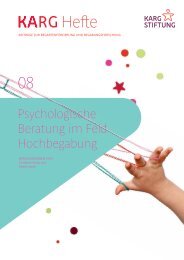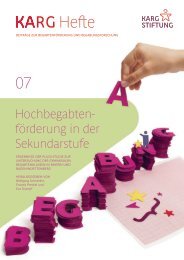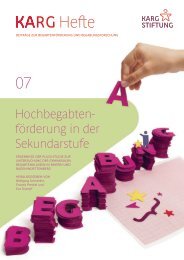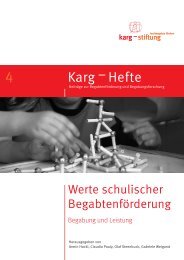FAQS: Frequently asked questions about giftedness
The Karg Foundation receives a lot of questions on the subject of giftedness—FAQs (Frequently Asked Questions)—far more often indeed than it did ten years ago. And this is a good thing! Many people involved in the educational processes of children have come to realize that giftedness can also be a fundamental personality trait of children and adolescents. The Karg Foundation wants to answer the questions you may have not only as educational and psychological professionals in educational institutions or working as educational providers, policy makers, or in training and further education institutes, but as parents and gifted people also: What is giftedness? How can it be identified? Who can provide advise for gifted children and their families? How can they be supported in the best possible way?
The Karg Foundation receives a lot of questions on the subject of giftedness—FAQs (Frequently Asked Questions)—far more often indeed than it did ten years ago. And this is a good thing! Many people involved in the educational processes of children have come to realize that giftedness can also be a fundamental personality trait of children and adolescents.
The Karg Foundation wants to answer the questions you may have not only as educational and psychological professionals in educational institutions or working as educational providers, policy makers, or in training and further education institutes, but as parents and gifted people also: What is giftedness? How can it be identified? Who can provide advise for gifted children and their families? How can they be supported in the best possible way?
Create successful ePaper yourself
Turn your PDF publications into a flip-book with our unique Google optimized e-Paper software.
How can gifted students be<br />
supported in the classroom?<br />
A classroom in which teaching follows the “one pace<br />
fits all” approach, with the whole class expected to work<br />
on the same assignments at the same speed, is fortunately<br />
in many schools now a thing of the past. In contemporary<br />
classroom instruction, growing emphasis has been placed<br />
on the learning levels of individual children and youth and<br />
on providing the amount of support, practice, and challenge<br />
needed by each individual student to learn effectively.<br />
What this means for gifted students is that they<br />
often start class with a higher level of prior knowledge, are<br />
able to acquire new knowledge at a much faster rate, and<br />
require less practice and repetition. The time that is gained<br />
can be well used for further learning or working on<br />
(self-chosen) projects. It goes without saying that gifted<br />
students also need assistance and guided practice—though<br />
usually on a different level and at a different pace than<br />
other children. A challenge in this kind of differentiated<br />
teaching is to avoid singling out or isolating students and<br />
to consistently provide opportunities for joint learning<br />
and interaction in the classroom. One promising approach<br />
involves the whole class working on the same subject<br />
matter at varying levels of proficiency and exploring in<br />
depth the different facets of the material. Social learning<br />
opportunities can also be provided through cooperative<br />
learning in small groups, where gifted children can work<br />
on more advanced topics with equally gifted peers who<br />
are faster learners. The attitude of the teachers is also<br />
fundamental for providing effective support of gifted<br />
students in the classroom. If they are able to recognize<br />
that the learning needs of a gifted child in the class are<br />
legitimate and are willing to find appropriate assignments<br />
and projects for that child, then the odds are high that<br />
these support efforts will yield successful results. In contrast,<br />
the idea of using gifted and fast-learning students in the<br />
classroom as “assistant teachers,” that is, allowing them<br />
to exclusively help other children in the time they have<br />
gained, has not proven to be an effective solution.<br />
78 79
















